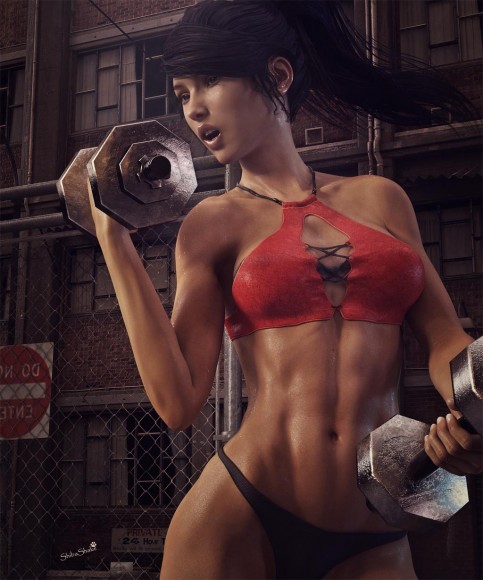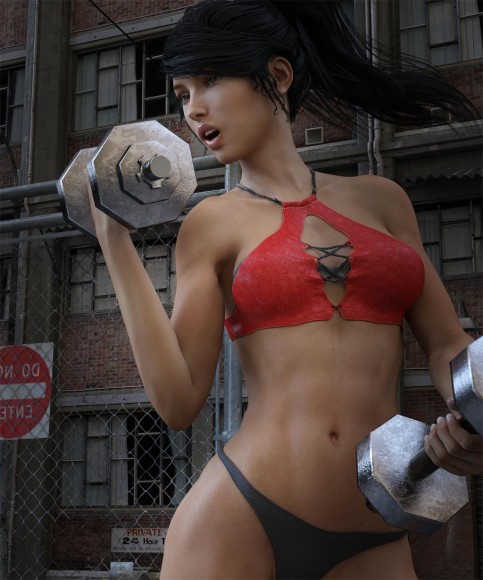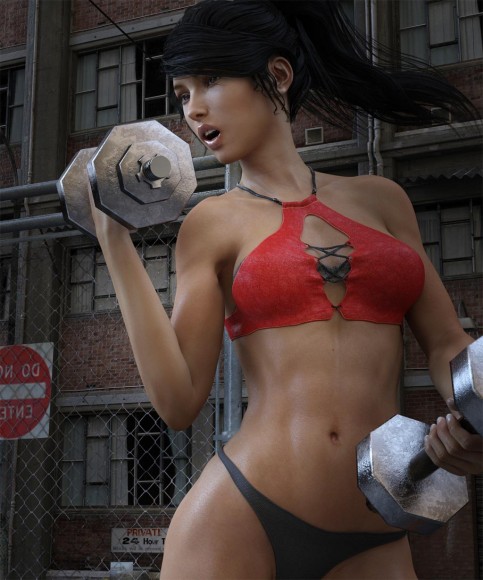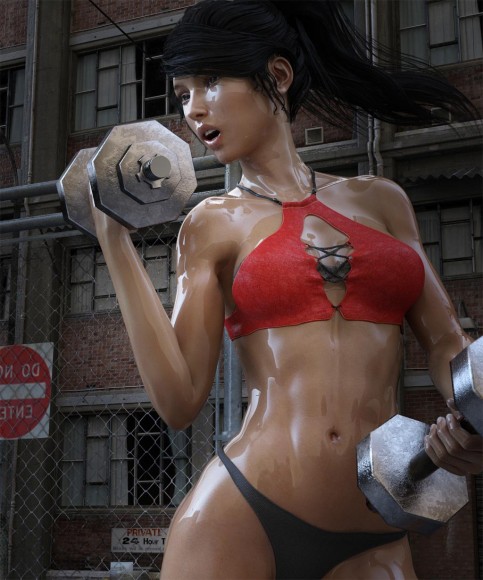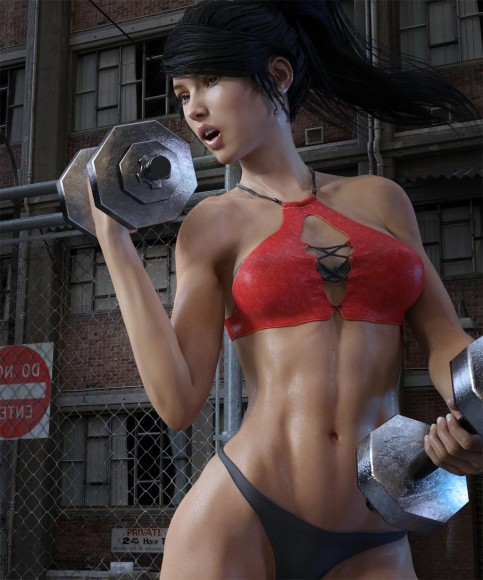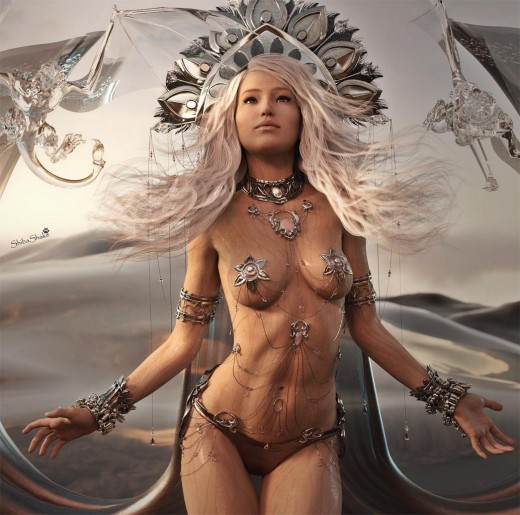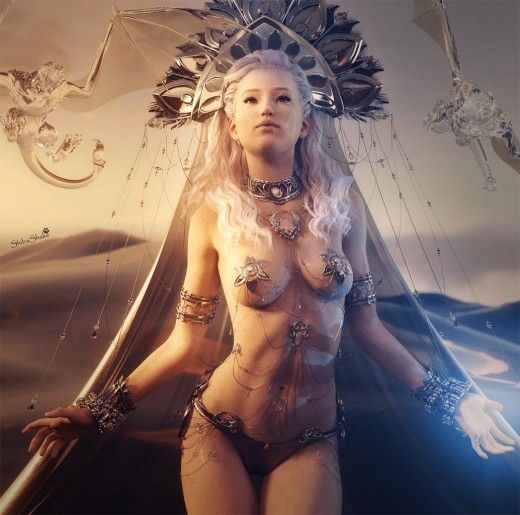After seeing Dave’s wonderful wet skin image on the Daz Gallery, I was inspired to try creating a wet skin render in Daz Studio Iray.
Creating wet skin involves three key steps-
1. Making the composition fit. If our figure is to have wet skin, then we want our composition to support that.
2. Making the skin properly shiny. Wet skin is more shiny and reflective than dry skin because there is water on the skin’s surface.
3. Adding water drops on top of the skin. In addition to being more shiny, there will also be some drops of water clinging to the skin, and trailing down the skin.
1. Making the composition fit
First, I create my scene in Daz Studio. Since I want to focus on the skin, I want my figure to be fairly large, and to have a good amount of skin visible. In addition, she should be doing something that will result in wet skin. In this image, I decided to create a dynamic scene, featuring Victoria 7 exercising with weights. Hair is NJA Ponytail Hair, which is one of my favorites. Outfit is Heat Up for G3F and G2F.
Below is the first pass of my composition with regular Victoria 7 skin. Lighting is just with an IBL. At this point, the skin does not look very wet.
2. Making the skin properly shiny
Next, I want to change certain settings on my Victoria 7 skin to make it more shiny. To do this, I select my Victoria 7 figure, and go into Surfaces > Editor. I select my V7 skins and make the following parameter changes –
- Glossy Layered Weight set to 1.0.
- Glossy Reflectivity set to 0.9.
- Glossy Roughness set to 0.4. This can be set lower if we want to increase the wet effect on skin. Setting it too low though, will make the skin look unrealistically shiny. Therefore, tweak it according to personal taste.
- Top Coat Layering Mode set to Fresnel. Top Coat IOR set to 1.49 and Top Coat Thin Film IOR set to 1.4. Again, Top Coat Roughness can be adjusted according to taste. A lower Roughness value will increase shininess and a higher Roughness value will decrease shininess.
3. Adding water drops on top of the skin
There are multiple ways to achieve this final step. I use a simple technique here, which utilizes the Daz Studio geometry shell.
- First, I select my Victoria 7 figure.
- Next, I go into Create > New Geometry Shell. This creates a shell over our Victoria 7 figure.
- I then select the Geometry Shell and apply the Iray Water shader to it.
- I go to Parameters > Mesh Offset and set the Offset Distance to 0.001.
In the image above, she looks like she has cellophane wrapped all around her. This looks strange because water on our body does not form an even continuous shell. Instead, we only want certain small parts of the shell to be visible, simulating water droplets.
To do this, I do a search on “water condensation bump”. I download an appropriate black and white water condensation image, and apply that to the Cutout Opacity parameter of my geometry shell. I can then adjust the Horizontal and Vertical Tiles parameter to control how much water there is. I decided to go for the more subtle effect here with water drops that are not overly prominent.
Finally, I also add some mesh lights to further accentuate the shininess of my wet skin and shell.
Another way to achieve water droplets on skin is to use crafted specular maps. This is what is done in Genesis 8 Wet Body Iray by SimonWM. He also has a variety of shells for the other Genesis figures. More recently, Hellboy released Real Drops Male Edition, which looks superb. Finally, V3Digitimes also has some great wet skin products, including Wet And Tanned Skins For Genesis 8 Female(s).
In the image below, I used Wet Body Geometry Shells by SimonWM. This is what I did –
- I apply the Wet Body geometry shell to a G2F figure (Victoria 6).
- I select all surfaces on the geometry shell and apply the Iray Uber shader.
- I set Glossy Weight to 1.0, Glossy Reflectivity to 1.0, and Glossy Roughness to 0.
- Finally, I can further control the strength of the drops by changing Translucency Weight. A value of 0 has the strongest wet map.
This first image has a stronger wet body look, and uses the specular Sweat Rolling map. For contrast, we also use a more subtle wet body look, and the Water Beads specular map.
